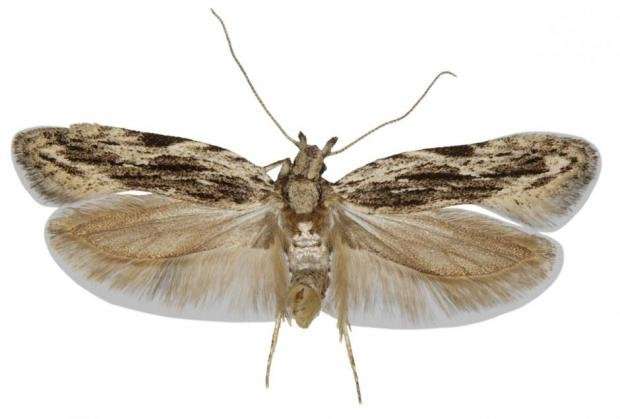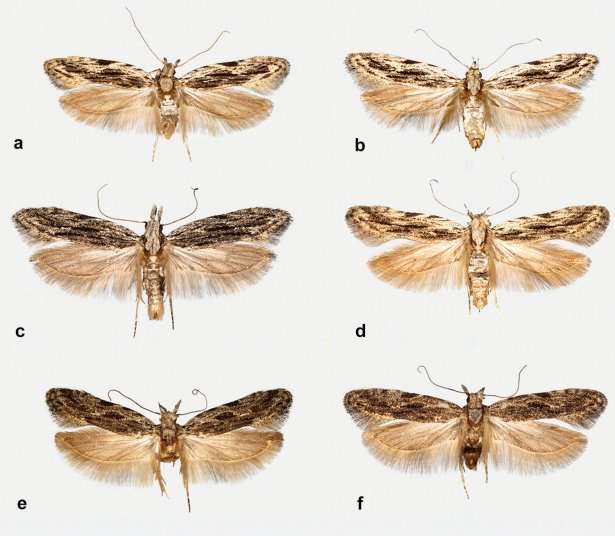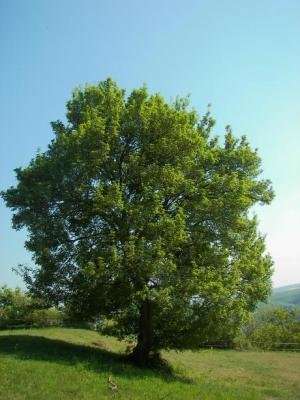New moth species discovered in Denmark

Scientists have discovered a new species of moth in northern Europe, which was previously unknown to science.
It is a type of moth from the family Gelechiidae and the scientists have given it the Latin name, Anarsia innoxiella.
According to their new study, Anarsia innoxiella is widespread throughout the UK and Scandinavia, and it is a unique discovery for this part of the world.
"It is common to find new moths in many places around the world, but it takes a long time to find new species in northern Europe. So it's really exciting to be able to describe a new species in Denmark," says moth specialist Ole Karsholt from the Natural History Museum of Denmark, and co-author of the new study.
An innocuous new species
Anarsia innoxiella had not been identified until now, because it closely resembles its relative, the peach twig borer, or Anarsia lineatella in Latin—a type of moth.
This moth has a reputation as a trouble maker, since its larvae are known to ravage peach, plum, and almond trees. For decades, scientists thought that the peach twig borer lived in Denmark and Northern Europe, but the new study shows that this is not true. And what they thought was a peach twig borer was actually an unknown species of moth.
"It shows that the peach twig borer doesn't live in Denmark or in other northern European countries. It's only this new species that lives here in the north, while the peach twig borer lives further south," says Karsholt.
This case of mistaken identity inspired Karsholt and colleagues to name the new species, Innoxiella, which comes from the Latin, innoxus, meaning innocuous or harmless.
"The new species is quite harmless—it's not a pest like the peach twig borer," says Karsholt.

An unusual and important discovery
Entomologist Thomas Simonsen from the Natural History Museum, Aarhus, Denmark, describes the new species as an important scientific discovery. But it is also significant for practical reasons, he says.
"It's important to correctly identify pests for many reasons, otherwise you could waste a lot of time and money controlling an animal, which isn't worth controlling. Now we know that it isn't a peach twig borer but a completely harmless animal," says Simonsen, who was not involved in the new study.
It is an unusual situation, he says. For decades, science has overlooked a species that is widespread throughout much of Europe.
"The new species lives in Denmark and the UK, probably the two countries where nature is best described. So it's fascinating that you can still make new discoveries here," says Simonsen.
Mistaken identify almost had serious consequences
The peach twig borer originated from southern Europe, and was first discovered in Austria in 1839.
The holotype (the single specimen used to describe and name a species) is held in the Natural History Museum in London. But according to the new study, this holotype belongs to the peach twig borer, and not the newly discovered species, Anarsia innoxiella, says Karsholt.
Unravelling the mistaken identity was the result of decades of detective work, tracking the false peach twig borer's behaviour.
When the 'false' moth first arrived in Denmark in 1959, authorities considered taking drastic measures to stop the spread of the newly discovered pest and decimation of plum orchards.

"It was found in South Zealand and the authorities at the time seriously considered felling all of the plum trees in the area. It was nonsensical, especially now that we know it was an entirely different species, which is harmless and doesn't live in plum trees," says Karsholt.
Harmless moth lives off field maple
Anarsia innoxiella larvae actually live off field maple, a type of deciduous tree, while the peach twig borer prefers fruit trees, eating plums, peaches, almonds and other stone fruits.
In the 1970s, Karsholt began to wonder why nobody had found any of these 'peach twig borers' in fruit orchards.
"I became suspicious, because when the moth larvae are associated with a certain type of plant, it's unusual to see them on other plants. But the problem was that when we looked at the moths emerging from the larvae feeding on field maple, they really resembled the peach twig borer," says Karsholt.
Different DNA and appearance
Karsholt and his friend, Keld Gregersen, studied a number of specimens from Denmark and compared them with samples collected elsewhere in Europe. They saw minute difference in the insects' wings and sex organs.
"We also saw differences in their DNA and so we knew that it was a different species," says Karsholt.
"We've found the new species in Scandinavia and the UK, and in many countries throughout Europe, all the way down to the Balkans. But until now we simply thought it was a peach twig borer," he says.
The peach twig borer is listed as a pest in Denmark, but the new study suggests that they do not exist north of Germany.
"In Denmark we didn't attempt to control the (false) peach twig borer, because we quickly realised that it wasn't a problem. But other countries to the south have used a lot of resources to control it, so I can imagine that some of them have in fact been controlling the wrong species," says Simonsen.
Where to find the new species
Anarsia innoxiella can be found in woods or your back garden. They live in field maple trees where they transition from a larvae into a moth in July.
If you live in a city then you may catch a glimpse of one in your local park or botanical garden. They are not rare, but are often tricky to see as they fly at night.
The last new moth discovered in Denmark was the Coleophora parthenogenella in 2010.
More information: Keld Gregersen et al. Taxonomic confusion around the Peach Twig Borer, Anarsia lineatella Zeller, 1839, with description of a new species (Lepidoptera, Gelechiidae), Nota Lepidopterologica (2017). DOI: 10.3897/nl.40.11184
Provided by ScienceNordic
This story is republished courtesy of ScienceNordic, the trusted source for English-language science news from the Nordic countries. Read the original story here.
















